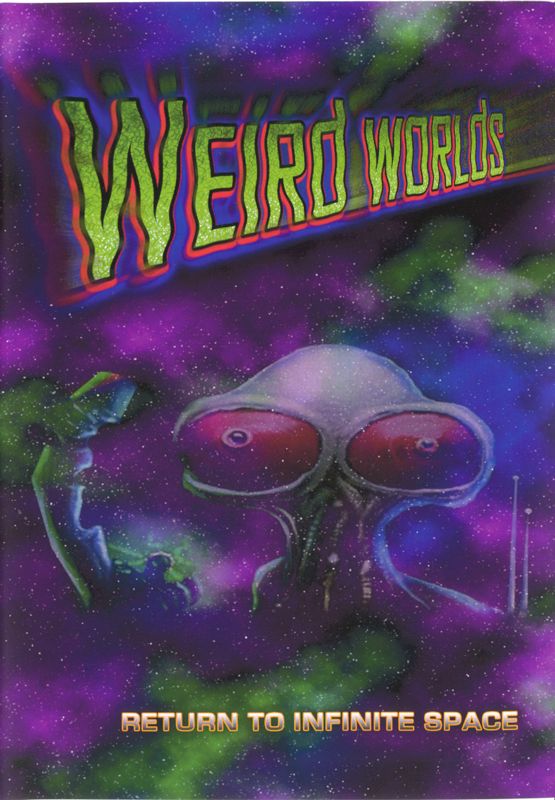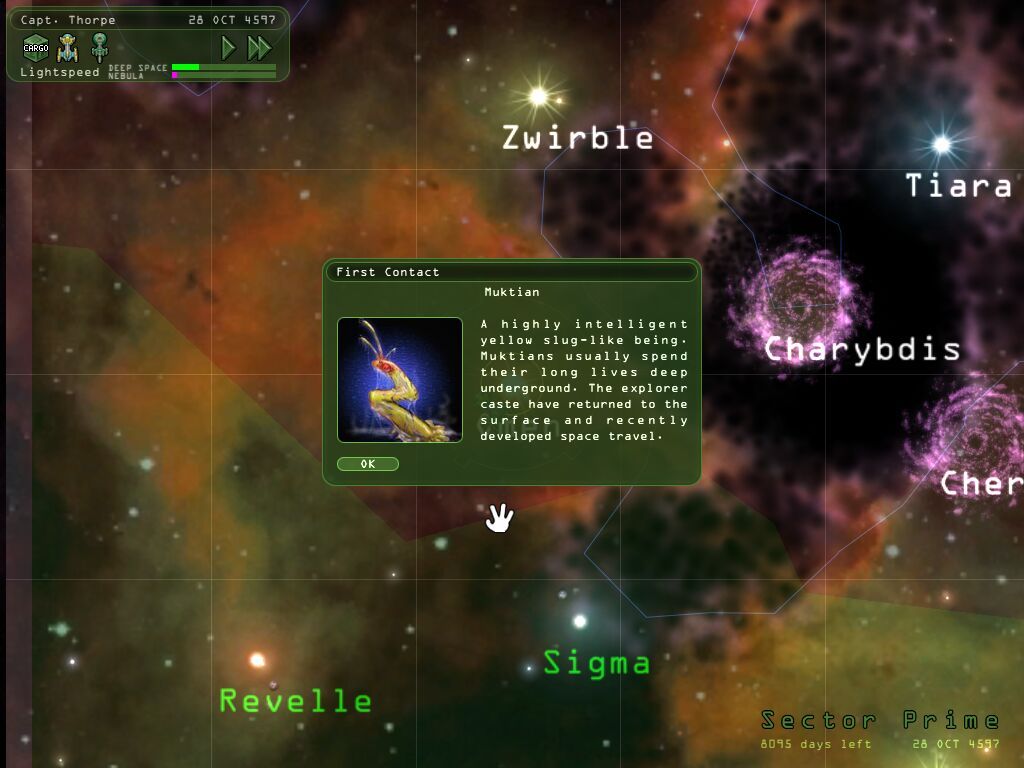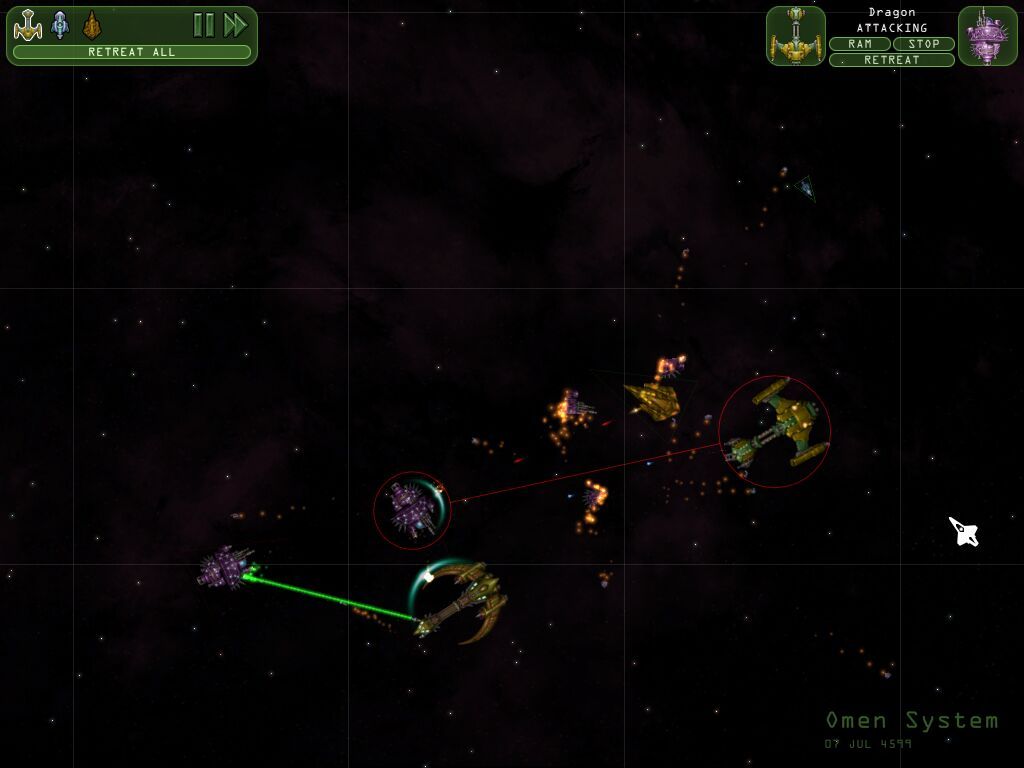Retro Replay Review
Gameplay
Weird Worlds: Return to Infinite Space picks up where its predecessor left off, offering a bite-sized but endlessly repeatable starship expedition. From the moment you select a military, science, or pirate mission and choose your voyage length (10, 20, or 30 years), you know that each run will feel fresh. The strength of enemy races and density of nebulas is entirely in your hands, turning each playthrough into a unique challenge. This procedural universe ensures that no two sessions are ever identical, encouraging experimentation and strategic adaptation.
(HEY YOU!! We hope you enjoy! We try not to run ads. So basically, this is a very expensive hobby running this site. Please consider joining us for updates, forums, and more. Network w/ us to make some cash or friends while retro gaming, and you can win some free retro games for posting. Okay, carry on 👍)
Traveling across the starfield is deceptively simple: point and click to jump between star systems, then deploy your ship on planets rich with potential resources or hidden dangers. Each world you visit presents a short textual description, but those few lines of lore can hint at powerful artifacts, mercenary outposts, or alien swap meets. Balancing risk versus reward becomes a constant mental puzzle, especially when time is ticking and you’re racing back to Glory before your mission timer expires.
Ship customization and fleet management add meaningful layers of depth. Starting with one of three base ship types, you can upgrade armor, weapons, and specialized equipment as you discover new tech. Hiring mercenaries not only beefs up your firepower but also opens the door to formation tactics, ship-to-ship equipment swaps, and protective escorts for vulnerable science vessels. These systems let you fine-tune your approach: strike fast as a pirate raider, mount a scientific deep-space probe, or marshal a military flotilla for overwhelming force.
Space combat in Weird Worlds is tactical yet brisk. Battles play out over a small grid, with your ship’s hardpoints chipping away at enemy shields and systems. While combat doesn’t demand intense micromanagement, it rewards thoughtful positioning, shield management, and weapon selection. Beyond fights, random phenomena—from supernovae to wormholes—keep you on your toes, and secret side-quests can pull you off course for rare rewards. All in all, the gameplay loop is tight, engaging, and perfectly paced for a quick 20-minute session.
Graphics
Weird Worlds embraces a clean, retro-inspired aesthetic that feels both nostalgic and functional. The starfield backdrop is simple but atmospheric, with adjustable nebula density adding color and variety to each map. Planets are represented by minimalist icons, yet each one carries enough visual flair to distinguish a lush Earth-type world from a barren rock or energy-rich gas giant.
Ship and fleet icons are clear and easily identifiable, ensuring that even in the heat of tactical engagements you won’t confuse your destroyer for a frigate. The UI panels use contrasting colors and straightforward layouts, presenting vital information—hull integrity, shield strength, available hardpoints—at a glance. While it won’t compete with modern 3D space shooters, Weird Worlds’ visuals serve the gameplay exceptionally well, keeping focus on strategy over spectacle.
Text descriptions are woven into the visuals, with planet narratives and event pop-ups overlaying semi-transparent panels that maintain immersion. Small touches—like blinking warp-drive indicators or animated shield arcs during combat—imbue the game with personality. The subdued color palette ensures that prolonged play sessions remain easy on the eyes, which is crucial for a title designed around multiple short expeditions in one sitting.
Story
Rather than a linear narrative, Weird Worlds thrives on emergent storytelling. Your adventures are written on the fly as you encounter alien species, stumble upon secret quests, and accumulate bizarre artifacts. Each session tells its own tale: a daring pirate heist, a peaceful diplomatic outreach, or a frantic escape from a dying star.
The three mission themes—military, science, and pirate—act as framing devices more than full-fledged plots. A military campaign might see you forging alliances with friendly races and crushing hostile fleets, while a science mission emphasizes exploration and artifact collection. These loose story threads give context to your actions without imposing rigid objectives, allowing you to craft your own mini-sagas within the time limits.
Planet descriptions and random event text are where Weird Worlds truly shines. Brief but evocative writing brings each world to life, hinting at lost civilizations, cosmic anomalies, or hidden wormholes. These narrative seeds often lead to tactical decisions—whether to risk rocking the diplomatic boat for an elusive artifact or to play it safe and refuel at a trading post. The result is a dynamic story that unfolds uniquely for every player, fostering a sense of discovery that rewards curiosity.
Overall Experience
Weird Worlds: Return to Infinite Space is a masterclass in focused, replayable design. In about twenty minutes you’ll experience exploration, ship upgrading, tactical combat, and emergent storytelling—all wrapped in a procedural universe that never quite repeats itself. The bite-sized session structure makes the game perfect for both quick break-room sessions and longer evening marathons of randomized space adventures.
The learning curve is approachable, thanks to a helpful tutorial mode and a tactical battle simulator for honing your combat instincts. Mod support further extends the game’s lifespan, with community-created expansions adding new ships, events, and balance tweaks. Whether you’re a longtime fan of indie space sims or new to the genre, Weird Worlds offers a satisfying blend of strategy and surprise.
It’s worth noting that the game’s retro graphics and text-heavy presentation may feel dated to those expecting flashy visuals. Occasional RNG frustration can arise when a run hinges on a single dice roll. However, these minor drawbacks are outweighed by the sheer joy of charting a random galaxy, collecting exotic artifacts, and beating the clock to make it back alive.
In summary, Weird Worlds strikes a rare balance: deep enough to reward strategic planning, simple enough to pick up instantly, and varied enough to beckon you back for dozens of runs. If you crave a bite-sized yet memorable starship journey—complete with emergent narratives, tactical skirmishes, and customizable fleets—this indie gem is well worth a place on your shelf.
 Retro Replay Retro Replay gaming reviews, news, emulation, geek stuff and more!
Retro Replay Retro Replay gaming reviews, news, emulation, geek stuff and more!









Reviews
There are no reviews yet.